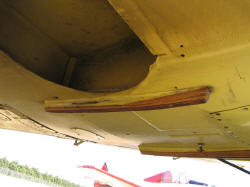Wing Skids For Mooney M-18s
by Gil Gilbert
After reading the article by Boyd Maddox about replacing the possum belly on N6033V [Mite of the Month, September 2004], I thought you all might be interested to know there is a way to prevent replacing the possum belly and other wood repair. About that possum belly, I don't know how big possums grow in Houston but around here in Western Washington the only ones I see are smashed flat on the highway. I assume the possum belly is the sheet metal on the bottom of the wing under the seat.
When I was shopping around for a Mite in 1973, I talked to a local pilot that owned two L models painted the same. He showed me some skids he glued on the bottom of the wing after he landed gear up. The trim was hooked up wrong and he forgot to put the gear down. Skids sounded like a good idea and they looked good. I bought N4121 in 1973 and flew it until annual time in May, 1974. The first check the IA made was to lift up on the fuselage near the tail skid. The IA gave me ferry permit to fly it back to home base to fix the fuselage. The two bottom bushings where the wood is bolted to the steel truss were loose and the wood joints were coming apart. To get the Mite airworthy I had to build a new fuselage, vertical tail, horizontal tail, and do extensive work on the wing center section.
| 1 | 2 | 3 |
Back to the skids. After I finished the wing in 1977, the IA let me install two strategically located skids. Pictures 1 & 2 show the skids on N4121. Picture 3 shows the clearance between the bottom of the wing and the bottom of the skid. I thought it was a good idea and they looked good.
In 1975 or 1976, another local pilot in Mite #357 (a C-55) made a gear up landing and messed up the possum belly, ground off about a half inch or so off the main spar, and ground off some of the inboard flap hinges. Naturally he got the prop, some sheet metal behind the nose gear, and ground off a small amount of metal from the front of the nose gear above the nose wheel. I talked the IA into installing skids on #357 because I thought it was a good idea and they looked good. In 1986 at the WAMM fly-in at Nevada Co. airport near Grass Valley, CA, good ole #357 did it again. This time all that was required to fly home was a good prop. The skids saved the wing spar, the flap hinges, and the possum belly.
 |
 |
 |
| 4 | 5 | 6 |
During the last WAMM fly-in at Porterville, CA, Dave Rutherford took some pictures of the repair to #357 as shown in pictures 4, 5, & 6. Picture 4 shows the skids after the repair. They are still a good idea but these don't look very good. Picture 5 shows the sheet metal repair. I believe the large cut-out was the first repair and patch at the rear of the nose wheel was the second repair. Picture 6 shows the flat spot on bottom part of the shock strut.
Another place to look for repair is on the bottom front and back of the main spar. There should be re-enforcement plywood plates glued to the spar. Dave could not take pictures of those areas because of an aux fuel tank and the seat.
The skids are made of stripes of 1/8 inch birch plywood, one inch wide, and as many stripes as necessary to obtain about a half inch clearance with bottom of the wing. The skids are 20 inches long, extend one inch behind the rear spar, extend one and a quarter inches in front of the main spar, and are 21 inches apart. If the skid extends too far in front of the main spar it may break and cause more damage.
16 October, 2004